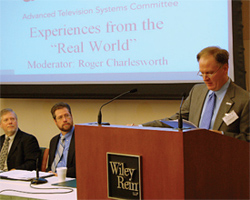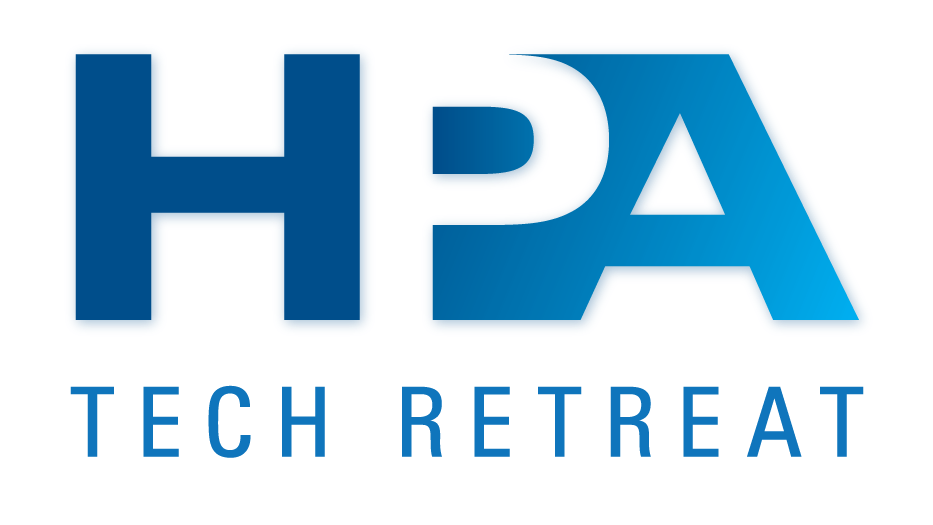ATSC Hosts Audio Seminar
WASHINGTON
A long list of television audio movers and shakers assembled here on Nov. 4 for the Advanced Television Systems Committee's full-day "Seminar on Audio Loudness."
The event attracted audio equipment manufacturers, major television network engineering personnel, consulting engineers and station chief engineers from several markets.
It also marked the eve of the balloting for acceptance of the ATSC's "recommended practice" document addressing audio issues associated with digital television. Several years ago, the ATSC initiated a strategic plan to treat loudness and A/V sync problems, and in 2006, a technical and standards group (TSG) was established to begin work on the issues, according to association President Mark Richer. "These are non-trivial issues and took take time to properly address," he said.

(L-R) Jim Kutzner, PBS, and Dave Higgins, Comcast Media Center and Jim Starzynski, NBC Universal. ©NATSC, Lindsay Shelton-Gross After two years of industry-wide work and involvement, the TSG completed development of the comprehensive document: "Recommended Practice ATSC A/85–Techniques for Establishing and Maintaining Audio Loudness for Digital Television." Balloting on the document closed moments before midnight on Nov. 4, and while the announcement of its acceptance by group members was still a day away, there was general elation at the seminar about completion of work on the document.
"We feel like this is a 'wrap party'—the home stretch," said Jim Starzynski, leader of the ATSC's S6-3 audio loudness group and principal engineer in advanced technology for NBC Universal.
RECOMMENDATIONS
The 66-page set of recommended practices is intended to guide audio creators and broadcasters in producing and transmitting high-quality DTV audio that is pleasing to viewers. It focuses on measurement techniques, production and post-production monitoring, as well as ways to control loudness. It also provides recommendations on controlling program-to-interstitial material level changes, the use of metadata in audio processing and other relevant topics now that transmission of audio with a dynamic range of more than 100 dB is possible. (For more details, see "The ATSC's New Recommended Practice on Loudness")
On the minds of many at the seminar was the CALM (Commercial Advertisement Loudness Mitigation) bill introduced in the U.S. House of Representatives earlier this year by Rep. Anna Eschoo. The bill attempts to address a growing number of complaints received about extreme television audio loudness variations, primarily associated with commercial breaks.
David Donovan, MSTV president, commenting on the relation of the TSG's work with the CALM bill, said, "We would have been in much worse shape if the ATSC hadn't started work on this a few years ago."
Donovan said that Eschoo's initiative was basically directed at loudness of spots delivered by analog television FM audio technology. He noted that ATSC members had wasted little time in making the bill's proponents aware of the work underway in connection with the A/85 recommended practices, and that this had made for a better understanding of the industry's own efforts in controlling audio problems.
"The bill [by itself] would have undone two years worth of ATSC work," he said. "We think that the bill now is far better than what was originally introduced."
Donovan's comments on possible legislation to tackle TV audio complaints were echoed by Richer. "Some of the problems have been minimized and there is some momentum," he said. "This industry needs to take care of its own problems."
CHANGES IN TV AUDIO
During a panel on real world audio issues broadcasters and content creators face in the transition from analog to digital, Starzynski reflected on a recurring "theme" within his organization.
"The biggest difficulty wasn't in working with content producers, but rather from within," he said. "I was frequently asked 'Can you please tell me why NBC is softer than anyone else on the dial?' My response was that we weren't soft, but rather that everyone else is too loud and they're wrong. Fortunately, that perception has gone away."
Greg Coppa, another panelist, and director of advanced technology and engineering at CBS, offered advice for producers of television programs.
"Produce content for the television marketplace—not the movie theatre market—please."
Jim Kutzner, chief engineer at PBS, referred to the move from analog to digital audio transmission as a cultural change.
"We simply did it," he said. "We had to bite the bullet and not ease into it [digital audio]. We're still finding that we have to work with our [established level] numbers. A lot of content is within our numbers, but a lot is not. Drafting a standard is a major step, but we still have a lot of work to do."
Panelist Jim DeFilippis, senior vice president of engineering at Fox, remarked too that much work still needed to be done. "Stations, for the most part, are still in an analog workflow," he said. "The 'golden rule' is that you shall set your dialnorm to average loudness."
"We're all still going through a training program now," said Kutzner. "And we will be for a long time."
Other presenters and panelists at the event included Pat Waddell, Harmonic; Steve Lyman, Dolby Laboratories; Tim Carroll, Linear Acoustic; and Sean Richardson, Starz.
The event was sponsored by DaySequerra, Dolby Laboratories, Jünger Audio, Linear Acoustic, NAB, the National Cable & Telecommunications Association, the IEEE's Broadcast Technology, RTW and Wiley Rein, LLP.
The professional video industry's #1 source for news, trends and product and tech information. Sign up below.
James E. O’Neal has more than 50 years of experience in the broadcast arena, serving for nearly 37 years as a television broadcast engineer and, following his retirement from that field in 2005, moving into journalism as technology editor for TV Technology for almost the next decade. He continues to provide content for this publication, as well as sister publication Radio World, and others. He authored the chapter on HF shortwave radio for the 11th Edition of the NAB Engineering Handbook, and serves as contributing editor of the IEEE’s Broadcast Technology publication, and as associate editor of the SMPTE Motion Imaging Journal. He is a SMPTE Life Fellow, and a member of the SBE and Life Senior Member of the IEEE.

